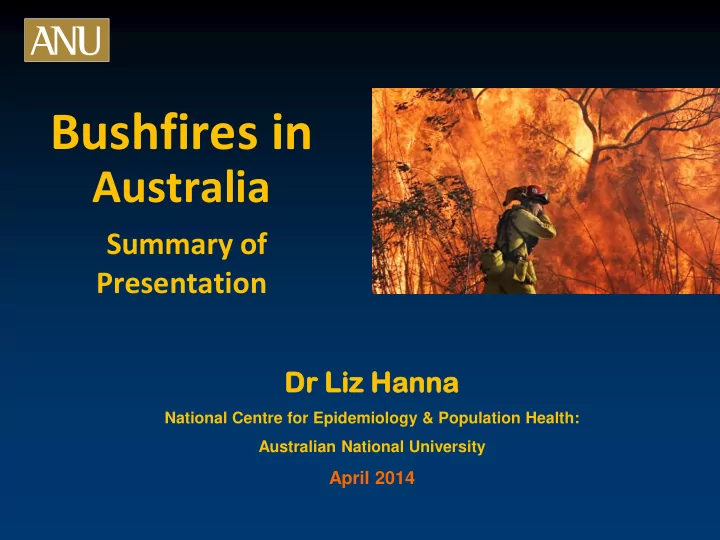

Bushfires in Australia Summary of Presentation Dr Dr Liz Ha z Hanna na National Centre for Epidemiology & Population Health: Australian National University April 2014
If Australia was in Northern Hemisphere 2 Liz Hanna – NCEPH ANU
40 year drying trend Australia’s population & Agricultural regions Victoria Liz Hanna – NCEPH ANU 3
Av Annual bushfires in Victoria 149 fires caused by lightning 145 fires deliberately lit 59 fires started as a result of campfires 53,096 hectares burnt each year by fire caused by lightning strikes: 15,649 hectares burnt each year by deliberately lit fires: 4 Liz Hanna – NCEPH ANU
Australian Bushfire Deaths 1939-2009 5 Liz Hanna – NCEPH ANU
Major Victorian Fires: 1851-2007 6 February 1851 (Black Deaths: 15 People rendered homeless: 100 Thursday) Buildings: 1,300 Livestock: 1 million sheep, thousands of cattle Area burnt: 5 million hectares (approx. 25%) of Victoria 13 – 20 January 1939 (Black Deaths: 71 People rendered homeless: 3,000 Friday) Buildings: 1,300 (including 69 sawmills) Livestock: 2,500 Area burnt: 1.5 – 2.0 million hectares 16 – 18 February 1983 (Ash Deaths: 47 People rendered homeless: 9,000 Buildings: 2,500 Wednesday) Livestock: 32,750 (including 18,000 sheep and 7,000 cattle) Fencing: 5,900 kilometres Area burnt: 210,000 hectares Estimated damage: $190 million 8 January – 7 March 2003 Deaths: 1 Buildings: 41 houses Fencing: 3,000 kilometres Livestock: 110,000 Area burnt: 1.3 million hectares 1 December 2006 – 7 Deaths: 1 Buildings: 51 houses Livestock: 1,741 February 2007 Area burnt: more than 1.2 million hectares 6 Liz Hanna – NCEPH ANU
Forest Fire Danger Index FFDI FFDI = 1.2753´ exp(0.987logDF + 0.0338T + 0.0234V - 0.0345RH), where • DF is the drought factor, • T the ambient air temperature in Celsius, • V the wind speed in km/h, and • RH the relative humidity expressed in percent Fire Danger Rating (FDR) system 7 Liz Hanna – NCEPH ANU
Victorian rainfall deficiencies: March 2005 – Feb 2008 18th March 2008 Liz Hanna – NCEPH ANU 8 Dr Liz Hanna
Fire situation January 2009 CFA attended 39,987 incidents & 16,103 fires DSE attended 825 bushfires Non extinguished fires • New years Day – 7 • January 14 th = 29 • January 25 th = 58 • February 7 = 128 Feb 7 = 632 incidents, 199 grass / scrub Fires DSE 117 fires 9 Liz Hanna – NCEPH ANU
Elements for a fire – at Extreme Australia has warmed 1.5-2 o C 1999 – 2009 = warmest in the 154 years of records January = Lowest rainfall on record, & worst heatwave Melbourne 3 consecutive days over 43°C = a record The four basic elements of fire weather: air temperature, relative humidity, wind speed and direction, and atmospheric stability th 200 Were all at record levels Fe February bruary 7 th 009 9 Temp 40 o C by 11 am RH < 10% By 12:30 T = 46.3 o C with Wind gusts 90 km/hr Spot fires 13 - 35 k’s ahead of fire front 10 Liz Hanna – NCEPH ANU
Feb 7 th 2009 Vic Fire Impacts Deaths = 173 Injuries = 800 people treated A&E, > 130 people admitted Homes & dwellings were destroyed = thousands ( >2K) Land burnt = 400,000 hectares, Stock losses = 4,500 sheep, 4,000 cattle and 200 horses Communities across Victoria directly affected > 78 Townships devastated - Marysville, Kinglake, Kinglake West, Narbethong, Flowerdale & Strathewen Fire-fighters – Country Fire Authority Volunteers = 19,000 Incident management & support Media – national & international 11 Liz Hanna – NCEPH ANU
New category of Fire Risk added after 2009 Conditions 12 Liz Hanna – NCEPH ANU
Changes in high & extreme fire weather (No. of days/yr) 2020 & 2050, relative to 1990 Increase in catastrophic fire danger days – return period in some areas < 3 years Lucas C, et al. 2007 Bushfire weather in southeast Australia: Recent Trends and Projected Climate Change Impacts. 13 Liz Hanna – NCEPH ANU
Bushfires affected communities Psychological responses: • Pre, during & post event . . . . lingering effects • Grief, loss, solastalgia, • Dislocation, uncertainty “living in limbo” • Children . . . . Indirectly through loss of • livelihood (agricultural, businesses, services), • Infrastructure (bridges, power, communications) • food yields, prices and nutritional quality 14 Liz Hanna – NCEPH ANU
Broader Impacts Health sector • Health care services – direct care • Community care & welfare agencies • Environmental health • Government Infrastructure • Costs - $593 million fire suppression effort • Costs - repair damage (conservative $4.3 billion) • Water storage contamination Downstream impacts • Tourism . . . Carbon release . . 1 million animals 15 Liz Hanna – NCEPH ANU
Recommend
More recommend